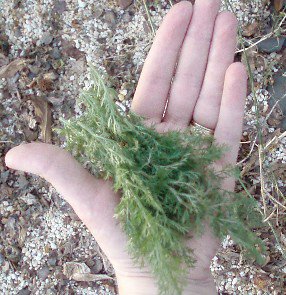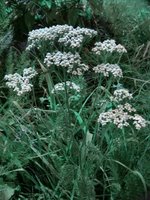
Yarrow is an ancient herb, with a distinguished lineage :)
Tradition would have it, that the herb was used by the Greek warrior Achilles, to heal his soldiers during the siege of Troy.
The Latin name for the herb is Achillea millefolium -- the origins of the Achillea are found in the story I just told you, the second part of it's name is from the French Mille feuille or Thousand leaves. Milfoil was the folk name used for Yarrow for many years, and the herbals of Culpepper, Parkinson and Gerard all use it in their listing of names. It refers to the appearance of the foliage of the plant... feathery fronds that remind me a lot of ferns.
It is very easy to grow, preferring poor soil to very fertile soil... a fact that betrays its weedy origins. It readily self-sows, and my garden has a number of volunteer plants that have sprung up... in the path, in other beds... you name it!
It seems to be one of the herbs in my garden that is susceptible to spider mites, but it is also the first to recover from them. Although it is only the end of January, my plants are already sprouted and growing... the mild weather only encouraging them.
Yarrow has a number of different medicinal uses... firstly, it is known to help aid the blood in clotting. According to Mrs. Grieve, wise women in Scotland were wont to use it to make a salve, which they applied to wounds. Modern herbal enthusiasts like to use it as garden first aid, myself included.

When cleaning up some garden debris the other day, I was dismayed to find a small cut between my thumb and index finger. I gathered a few yarrow leaves (a few too many really ;)), crushed them slightly, and held them to my cut. Within 15 minutes, all bleeding had stopped, as had most of the pain. It has not bothered me since.
Yarrow is also used in a variety of other ways... infusions are used to help urinary incontinence and dermatitis (especially eczema). It has also been used for a variety of feminine issues, not least for vaginal infections. It is first and foremost, however, used for purifying blood... and aiding the kidneys.
Yarrow has become increasingly popular with the flower arranging crowd... the flowerheads, which are shaped much like umbrellas, have now been bred into a varitey of colours in addition to the original white. You will often see yellow varieties dried for flower arrangements, but a personal favourite of mine is the red one :)
 Flower arrangers love it for both dried and fresh arrangements, the feathery foliage makes a wonderful contrast in the fresh arrangements, while the heads make a striking statement in the dried arrangements.
Flower arrangers love it for both dried and fresh arrangements, the feathery foliage makes a wonderful contrast in the fresh arrangements, while the heads make a striking statement in the dried arrangements.The old herbals also tell of using Yarrow in dream pillows... placing it beneath your pillow is supposed to give you dreams of your future spouse, says Mrs. Grieve in her A Modern Herbal.
Needless to say, I have no need of the last use, but the recent flare up of eczema on my daughter's skin is giving me pause...
the culprit is a fruit juice... 100% juice it says! But still, she is allergic. I wonder how good yarrow is with eczema... and do I need just the foliage or the flowers too?
For more information, you can consult your herbal books, or these links:
http://altnature.com/gallery/yarrow.htm
http://www.botanical.com/botanical/mgmh/y/yarrow02.html
http://www.gardenguides.com/herbs/yarrow.htm
http://aggie-horticulture.tamu.edu/wildseed/42/42.5.html
http://www.ashtreepublishing.com/Book_City_Herbal_Yarrow.htm
http://www.bcadventure.com/adventure/wilderness/wildflowers/yarrow.htm
